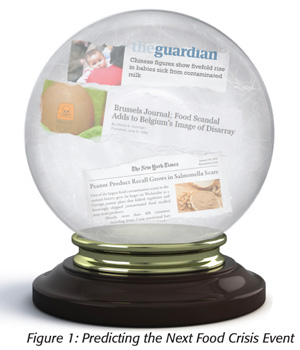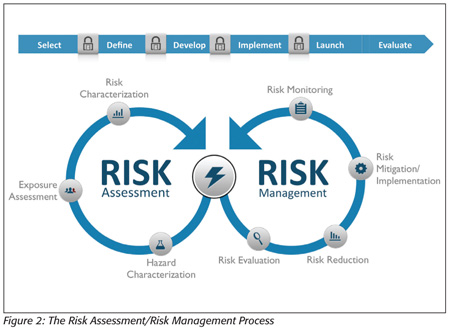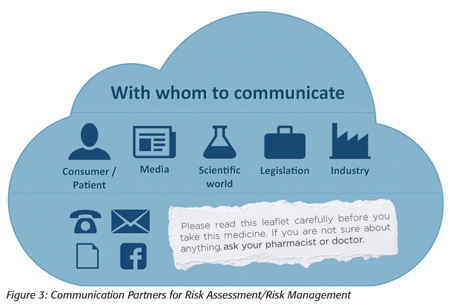 Numerous food scares all around the world, including dioxin in Germany and Belgium, Salmonella in peanut butter in the U.S. and melamine in China, have led to consumers losing trust in their food supplies, despite the fact that, as a general rule, food has never been as well controlled and safe as it is today. Notwithstanding all the safety efforts in recent years, in 2011 we saw some of the worst food scares ever, namely the Escherichia coli outbreak in cucumbers in Germany and the Listeria outbreak in cantaloupes in the U.S., with a death toll of 35 and 13, respectively. In the absence of a crystal ball that would allow us to predict the next crisis (Figure 1), there is clearly a need to better anticipate food safety risks to prevent similar crises from happening at all, or at least be prepared to face and manage them effectively, with a minimum impact on consumers.
Numerous food scares all around the world, including dioxin in Germany and Belgium, Salmonella in peanut butter in the U.S. and melamine in China, have led to consumers losing trust in their food supplies, despite the fact that, as a general rule, food has never been as well controlled and safe as it is today. Notwithstanding all the safety efforts in recent years, in 2011 we saw some of the worst food scares ever, namely the Escherichia coli outbreak in cucumbers in Germany and the Listeria outbreak in cantaloupes in the U.S., with a death toll of 35 and 13, respectively. In the absence of a crystal ball that would allow us to predict the next crisis (Figure 1), there is clearly a need to better anticipate food safety risks to prevent similar crises from happening at all, or at least be prepared to face and manage them effectively, with a minimum impact on consumers.
Zero Risk vs. Appropriate Level of Protection
Taking risks is part of our life as human beings, and our society is well prepared to take risks in almost every domain of our daily life. We smoke, although we are told with every pack of cigarettes that “smoking can kill.” We drive cars and accept accidents with severe injuries and even the risk of untimely death. We fly in airplanes in the full knowledge that one crashes now and then. We build factories based on certain standards and specifications, taking into account “foreseeable events,” but never really the “worst case scenario,” as the Fukushima nuclear crisis clearly demonstrated.
Surprisingly, when it comes to food, consumers have come to expect “zero risk.” Whether fresh produce, meat and cheese, or processed foods like canned or aseptically filled food products, consumers in many countries claim the right to have safe, fresh and good-tasting enjoyable products with a long shelf life at a low cost. Only few are aware that there is always some measure of risk involved. Contradictions must be managed to meet all the paradoxical consumer expectations, and this has given birth to the concept of an “appropriate level of protection” in the food industry.
The concept can be illustrated by considering the risk management of carcinogenic genotoxic substances like aflatoxins, for which the threshold of no adverse effect cannot be calculated or experimentally defined. Instead, a threshold has been defined measuring the risk of hepatic cancer in the population as more than 1 case for 106 people. As a consequence, authorities admit that total protection of the population is not achievable, and the actual limit gives an appropriate level of protection in the way that it will generate no more than 1 hepatic cancer for 106 people due to aflatoxins.
Industry, retailers, authorities and media need to work together to inform and educate consumers about the appropriateness of this level of protection.
Hazard Identification
A risk analysis starts with the identification of a hazard. This could be microbiological contamination with Salmonella or E. coli, or chemical contamination with pesticides, mycotoxins or heavy metals. Hazards may be introduced in food through raw materials, processes and/or the environment. Primary packaging materials contain many chemicals that could migrate into the food and pose a risk for consumers. On top of everything, intentional contamination or manipulation of food products cannot be excluded and should also be taken into consideration. Additionally, nutrients like vitamins, minerals and trace elements could represent a hazard in case of over- or underdose.
The Risk Assessment/Risk Management Process
 After identification of the hazard, the real job of risk assessment/risk management begins (Figure 2).
After identification of the hazard, the real job of risk assessment/risk management begins (Figure 2).
Risk Assessment: Exploring Science and Technology
Hazard characterization: The starting point of the scientific and technological risk assessment is the hazard characterization, in which the nature of the hazard and the potential adverse effect are investigated. This requires a thorough understanding of the toxicity of a contaminant or the virulence of a particular microorganism, the ingested dose thereof, the consumption pattern of a food, the physiological condition of the target consumer group (e.g., infants), etc. Typically, the researcher starts with a literature search to understand the scientific status quo on the particular subject matter. Depending on the availability, scientific depth and applicability of the information, further studies like chemical or microbiological analyses, challenge tests, scientific or medical experiments or a field study may be required.
Exposure assessment: With a full understanding of the hazard, the next step investigates who may be exposed to a particular hazard and under which circumstances. The researcher evaluates the prevalence of certain conditions like allergies, or vulnerability toward certain microorganisms (e.g., Cronobacter sakazakii for infants) or ability to tolerate components like alcohol or enzymes, as well as consumption patterns.
Risk characterization: Using techniques like dose-response curves, the likelihood and impact of the hazard are then investigated. This may lead to the definition of performance objectives, food safety objectives, maximum residual levels or recommended daily allowances related to specific consumer populations.
The collected evidence of the risk assessment is used for the risk management cycle, with the intention of mitigating and managing the risk.
Risk Management: From Understanding to Mitigation and Management
Risk evaluation: As part of risk assessment, the likelihood and impact of a hazard on consumers in general are investigated by scientific means. The next step is to evaluate this risk for a specific product and its application, a certain target group, a particular population, age group, country or region, etc. The output of this risk evaluation is a food safety objective to be reached at consumption, which will give the appropriate level of protection for the population. This food safety objective could be broken down in several performance objectives to be reached at different steps of the food chain and that will participate in fulfilling the overall food safety objective.
As an example, to have an appropriate level of protection of babies from birth to 6 months, the food safety objective for C. sakazakii in infant formula has been set to 0.06 CFU/g at consumption. As there is no real step to reduce the risk between packaging and consumption, the performance objective at the end of the production step is set at 0.06 CFU/g. Subsequently, a microbiological criterion of “no presence of C. sakazakii in 30 × 10 g” will give a 95 percent confidence that each batch complies with the performance objective of no more than 0.06 CFU/g. Taking into account the within-batch variability of the occurrence of C. sakazakii, we should target a mean concentration of 0.007 CFU/g to reach 99 percent confidence that the batch complies with the performance objective.
Risk reduction: Once a risk has been evaluated, it may need to be reduced to comply with the performance objective. This could be done by changing a raw or packaging material, reformulation, change of processing, in-process or quality control, or labeling. As an example, the presence of an allergen needs to be clearly stated on the label, not only as part of the ingredient list, but with an additional comment such as “not suitable for...” or “may contain.…” The risk mitigation implementation step translates the risk reduction opportunities into practice.
Risk monitoring: The expectation is that these steps of the risk management cycle effectively fulfill the performance objectives and reduce the risk to the “appropriate level of protection” of consumers. Implementation of criteria or standards will allow verification that each batch of the production complies with the performance objectives. To validate this assumption, it is necessary to track the performance of the product in the market. In particular, any feedback from customers and consumers should be monitored to confirm the level of protection and gain any insights that may suggest that the hazard poses a consumer risk.
Communication and Collaboration: Food Safety Is Noncompetitive
 The risk assessment/risk management process requires ongoing communication. Providing safe food products to consumers is a shared responsibility of industry, retailers and authorities (Figure 3). Consequently, food safety is noncompetitive and requires collaboration of all stakeholders—including media, nongovernmental organizations, associations, etc.—as much as open communication. Information concerning hazards and related risks should therefore be publicly available. Many different means are available for sharing, like product labels, company and consumer websites as well as social media, conferences and the wide area of scientific to generic
The risk assessment/risk management process requires ongoing communication. Providing safe food products to consumers is a shared responsibility of industry, retailers and authorities (Figure 3). Consequently, food safety is noncompetitive and requires collaboration of all stakeholders—including media, nongovernmental organizations, associations, etc.—as much as open communication. Information concerning hazards and related risks should therefore be publicly available. Many different means are available for sharing, like product labels, company and consumer websites as well as social media, conferences and the wide area of scientific to generic
literature.
Conclusions
To anticipate potential food safety risks and protect consumers from food safety outbreaks, companies may use a stepwise process, allowing them to identify hazards, gather the scientific and technological evidence and effectively mitigate and manage the risks to achieve an appropriate level of protection.
Collaboration at all levels, within companies and—even more importantly—across companies, retailers, authorities and all stakeholders, is required to apply a multidisciplinary approach, view a hazard from various angles and fully leverage the enormous amount of existing knowledge. Effective risk communication is an important element to raise the level of risk awareness of all partners of the food chain, from “farm to fork.”
 Christian Mahr, Ph.D., graduated as a food chemist from the University of Wurzburg, Germany, and subsequently received a Ph.D. from the Technical University Munich, Germany. Following a postdoctoral fellowship at the University of California, San Diego, he held various positions from 1992 to 2005 in R&D and quality management at Kraft International, Hoechst AG, Onken Dairy and Campbell Soup Company. In 2005, he joined Nutricia (now part of Danone) as managing director of the Central Laboratories in Friedrichsdorf, Germany. In 2008, he was appointed director, quality & food safety, for Nutricia, Danone’s Medical Nutrition Division.
Christian Mahr, Ph.D., graduated as a food chemist from the University of Wurzburg, Germany, and subsequently received a Ph.D. from the Technical University Munich, Germany. Following a postdoctoral fellowship at the University of California, San Diego, he held various positions from 1992 to 2005 in R&D and quality management at Kraft International, Hoechst AG, Onken Dairy and Campbell Soup Company. In 2005, he joined Nutricia (now part of Danone) as managing director of the Central Laboratories in Friedrichsdorf, Germany. In 2008, he was appointed director, quality & food safety, for Nutricia, Danone’s Medical Nutrition Division.




